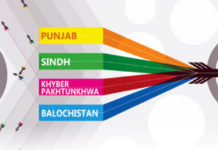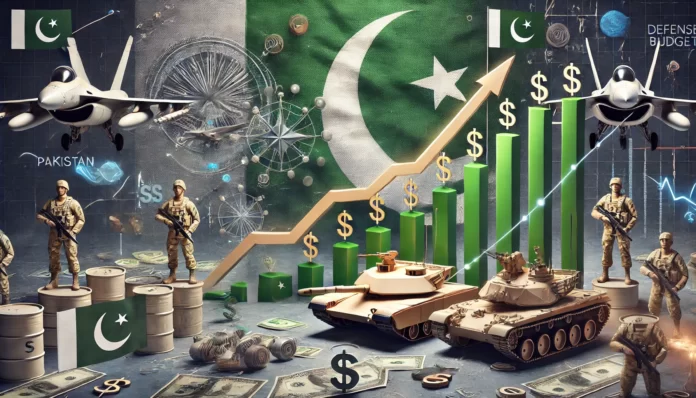One of the cornerstones of traditional “anti-establishment” politics has been Pakistan’s defence budget. The most significant matter that is brought up normally is the allocation for the military is far too high at the expense of other sectors of the economy.
For this story, we will set aside the debate regarding how much should be allocated for military spending in a country like Pakistan. Instead, let’s look at a different factor: The yearly increase in the military budget. This year, in the federal budget proposal, the amount of money proposed under defence expenditure has been raised by 15% marking a Rs 280 billion increase in the budget. The defence services head of the expenditure has been allocated a total of Rs 2.128 trillion for the upcoming fiscal year. This means that the defence services alone now account for 12% of Pakistan’s federal expenditure. This expenditure, as a percentage of Pakistan’s GDP now stands at almost 2% of the GDP.
But the increase is not quite what it may seem. Despite the increase, the military has not been immune to inflationary pressures. The question is what has been the real value of the military budget over the last four financial years? Has it gone up as much as we think it has? How much inflation has hit the military in real terms? And what does the rising trend in the military budget signify?
To make a righteous comparison one first needs to understand what the military budget is, its different components, and how it is divided.
Breakdown of the defence expenditure
The infamous defence budget called the “Defence Affairs and Services” is the main head under which defence expenditure is put. In this there are two sections, Defence Administration and Defence Services. Defence Administration, as the name suggests is only a small part of the job and hence only sets the exchequer back by Rs 6.78 billion. Meanwhile Defence Services is the main job, and Rs 2.212 trillion have been allocated for this purpose alone.
According to the documents revealed by the finance division, the only detail of this expense is given in four different types of expenditures. Employees related expenses which account for a major chunk of the military budget at Rs 815 billion. This mainly includes the salaries of defence personnel including the army, airforce and navy.
Other heads under the defence budget are operating expenses, physical assets and civil works. The amount of money allocated for each of these in the FY25 is 513 billion, 512 billion, and 244 billion respectively.
What most readers would be surprised to find out is that in the true sense of the word, the defence expenditure is not just the defence affairs and services, but includes other expenses accounted for in other parts of the budget. Apart from the approved defence budget head, an additional Rs 662 billion, almost 65% of Pakistan’s entire pension bill is also allocated for military pensions, as per the budget documents. Moreover, the ministry of defence budget contains a separate head for cantonment boards developments while a separate head for educational institutions inside the cantonment boards is allocated under its respective ministry.
Additionally for the past two years, a trend of revising the military budget upwards has been seen after the budget figure was approved, we will take the proposed figure as the budget for the entire year. In FY24, the defence budget was estimated to be 1.81 trillion in the proposed budget but was later revised to Rs 1.84 trillion, a 1.6 % increase. Similarly in FY23 Rs 1.57 trillion was allocated for defence affairs and services, however the federal government ended up spending in excess of 1.59 trillion under this head.
There is one other thing that the reader needs to know, if they are to understand their country’s military budget. And that is that the military budget is not always truly representative of how exposed a country is due to its defence spending. A country could be spending more than $100 billion on its military but have significantly less exposure due to various reasons. One of those reasons is the military expenditure as a percentage of GDP. While the defence expenditure as a percentage of GDP has come down in the last few years, Pakistan is still ahead of its neighbours and peers when it comes to defence.
According to the Pakistan Economic Survey 2023-24, defence spending as a percentage of GDP has decreased since 2020. It shows that defence spending was 2.6 percent of GDP in 2020, but decreased to 2.4 percent in 2021, 2.1 percent in 2022, 1.7 percent in 2023, and has been kept consistent at 1.7 percent in 2024. For 2025, defence spending has been retained at 1.7 percent of GDP, indicating no change in the share allocated to the military.
However, according to the World Bank, these numbers are a bit different. Since the WB follows a dollar based approach, Pakistan’s GDP military expenditure as a percentage of GDP was recorded at 2.6% in 2022. The number is neither small, in real terms nor small compared to our peers. As of FY22, in the south asian subcontinent, Pakistan spends the most percentage of its GDP on defence.

For the remaining two years of the world bank data, the dollar value has appreciated by a great extent and the GDP has not grown enough. This means that the figures of the next two years do not look up as positively as the Pakistan Economic Survey suggests. Pakistan is also the top country in this neighbourhood to spend on defence as a percentage of total government spending. For the past 20 years Pakistan has managed to stay upwards of 15%, the highest in the region.

It is also important to note that a large chunk of Pakistan’s budget is non-combat budget. What is a non-combat budget? Within the defence budget there is generally a distinction between combat and non-combat budget. For example, global military expenditure in the preceding year was the highest ever recorded in the history of the world in one single year. However, that is mainly accounted for in the combat budget.
As the name suggests, non-combat budget refers to expenses that are recurring. Expenses related to support and administration of the armed forces. It is also important to note that the part of this budget allocated towards combat is also not small. Since a lot of the military equipment and training is considered as a part of the combat expense.
The combat budget is primarily focused on enhancing operational readiness and defence capabilities. Meanwhile the non-combat budget addresses the broader administrative, logistical, and welfare needs of the military personnel.
Military Budget in real terms
When we talk about the expenditure in dollar terms, it is unfair to gauge the increase in the military budget in rupee terms. Even though the rupee value of the budget has increased, the military not only imports the latest combat technology but the military personnel who are being paid in rupee terms are also as susceptible to the inflation as a common man is. This means that the reliance of this budget on the dollar value is as strong as the country’s reliance on the dollar.
Surprisingly, the dollar value of the military budget in the last four years has not only reduced, but has reduced significantly. Over the last six years, Pakistan’s defence budget has decreased from $10.2 billion to $6.3 billion in dollar terms. While rivalling countries with bigger economies spend tenfold, Pakistan struggles to keep up with its current expenditure level in dollar terms each year. This would automatically lead to an increase, sometimes an even larger one in rupee terms. This is in fact one of the reasons why the military feels the need to expand its budget every year, during the middle of the year.
While the allocation, budgeting and tax collection in this budget places a huge question mark on the very viability of this budget, a case for increasing the military budget can be made quite easily.
The case against, on the other hand, is an ideological one. With close to 40% of the population under the poverty line and exorbitant taxation both direct and indirect, making life difficult for the common man, how much consolidation of the military budget should the government warrant? Unfortunately, as mentioned earlier, the case is a difficult one to make, in more ways than one.
























